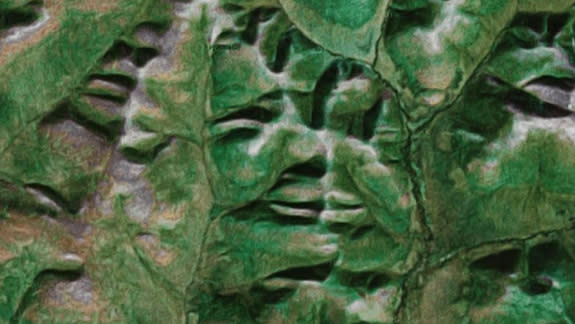Google Maps Gets a 'Face-Lift'

What happens when you combine Google Maps with facial recognition software? You get Google Faces – a search tool that scans the earth's surface, finding human features in unlikely places.
A project by Berlin-based design team Onformative, Google Faces was created to "spot all the faces that are hidden on earth."
The program works by scanning images from Google Maps using a face- detection algorithm that cross references with a face tracking library. When the program detects a face, the designers can see it right on their web browsers.
And once Google Faces completes its journey around the world, it makes the trip all over again, searching for faces at the next zoom level.
Onformative's Julia Laub and Cedric Kiefer said the idea for the project came from a desire to explore the phenomenon of pareidolia – the human tendency to see faces within inanimate objects.
If you've ever seen a face float by in a passing cloud or discerned the profile of an old man in the bark of a gnarled tree then you've experienced pareidolia.
What interested the creators of Google Faces most is a machine's ability to generate pareidolia in humans.
Laub and Kiefer said they drew much of their inspiration from the "Face on Mars," a 1976 photograph taken by NASA's Viking 1 Orbiter spacecraft, which captured what looked like a human face on the surface of the red planet.
Google Faces is an attempt to capture similarly suggestive images.
On their website, the designers state that one of a human's most characteristic features is his or her "desire to detect patterns" and use these patterns to "penetrate into the detailed secrets of nature" and "enrich our imagination."
And Google Faces speaks to these human desires. The program makes for one trippy adventure around the world. However, the images it captures aren't necessarily as striking as "Face on Mars," which is provocative mainly because of the alien landscape it portrays.
But Laub and Kiefer aren't the only ones exploring the intriguing nature of machine pareidolia. As facial recognition technologies become a part of our every day lives, other geeky-creative types are taking a closer look at this phenomenon, as well.
Last year, New York-based blogger Greg Borenstein talked to TechNewsDaily about a program he wrote that applied face-tracking technology to hundreds of photographs. The photos were all part of a Flickr group called "Hello Little Fella," which is dedicated to the faces people find in inanimate objects.
What Borenstein found most interesting about his exploration of the pareidolia phenomenon was a machine's tendency to see faces that human beings don't see at all.
To understand this aspect of machine pareidolia, it's important to note that pareidolia in humans is believed to be caused by "over-learning." In other words, we're so good at identifying faces that we start to see them even when they're not there.
Machines, once programmed, can also be a little too good at spotting faces. But their pareidolia manifests differently than ours. Why is that?
The geeky-creative set just isn't sure. But if programmers can figure out the how and why of this disparate machine pareidolia, they may gain a better understanding of how machines see the world.
Another interpretation is that by understanding machine pareidolia, programmers may be able to build machines that think more like humans. And in the age of lethal autonomous robots, that may or may not be a good thing.
This story was provided by TechNewsDaily, a sister site to LiveScience. Email asklizzyp@gmail.com or follow her @techEpalermo. Follow us @TechNewsDaily, on Facebookor on Google+.
Copyright 2013 LiveScience, a TechMediaNetwork company. All rights reserved. This material may not be published, broadcast, rewritten or redistributed.

